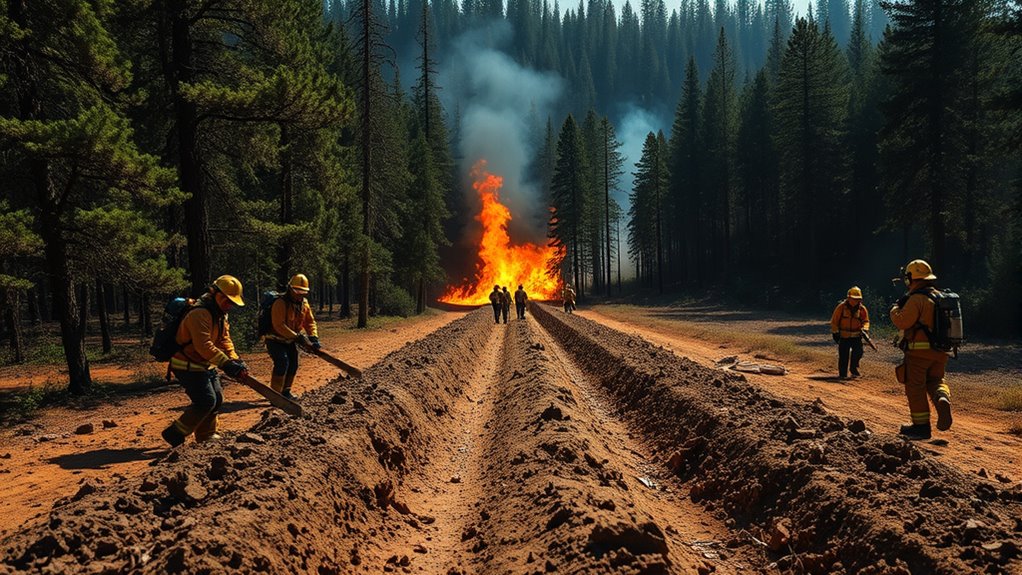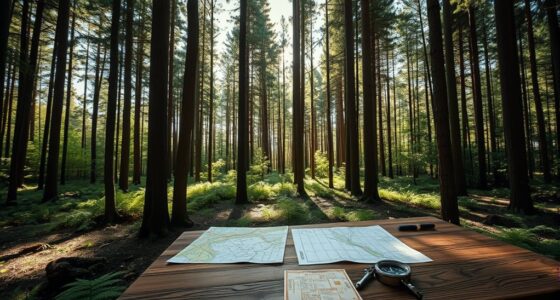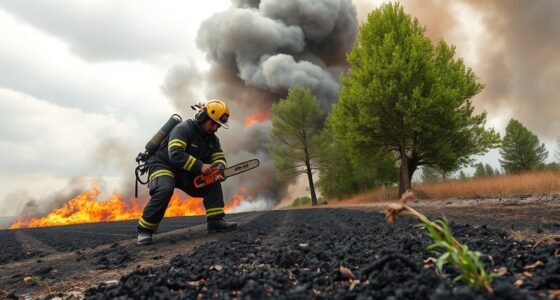To create firebreaks and fuel breaks safely, start by evaluating your land’s features, fire spread patterns, and natural barriers. Carefully select locations that maximize safety while minimizing land disturbance, and use proper removal techniques to reduce vegetation without causing erosion. Always wear protective gear and follow manufacturer instructions when operating machinery. Regular maintenance ensures they stay effective over time. Keep your barriers robust and clear, and for detailed guidance, explore additional safety tips further.
Key Takeaways
- Assess landscape features and natural barriers to optimize firebreak placement and effectiveness.
- Plan firebreak locations that maximize safety, accessibility, and fire containment.
- Use proper tools and techniques to remove combustible vegetation without causing soil erosion.
- Wear protective gear and collaborate with fire authorities to ensure safe installation practices.
- Regularly inspect and maintain firebreaks to ensure their durability and ongoing fire protection.

Creating firebreaks and fuel breaks is crucial for protecting property and lives during wildfires, but doing so safely requires careful planning and proper techniques. When you approach firebreak planning, you need to take into account the landscape, vegetation types, and the likely direction of fire spread. This initial step helps determine the best locations for your firebreaks, ensuring they provide maximum safety without unnecessary disruption to your land. Think about natural barriers like rivers or rocky outcroppings, which can be integrated into your plan. You should also evaluate access points for machinery and personnel, making sure they are safe and efficient to reach. Proper firebreak planning involves understanding fire behavior, weather patterns, and the surrounding environment so that your firebreaks serve their purpose effectively. Incorporating diverse designs and materials into your firebreak layout can enhance durability and effectiveness over time.
Once your plan is in place, the next critical step is fuel break installation. This process involves removing or reducing combustible vegetation and debris within designated areas to slow or stop the fire’s progress. You might clear shrubs, grasses, and fallen branches, creating a bare or low-growth zone that acts as a barrier. It is vital to use appropriate tools and techniques to avoid unnecessary soil disturbance or erosion. When installing fuel breaks, you should maintain a consistent width and ensure that the edges are clear and well-defined. This helps firefighters and landowners recognize the boundary quickly during an emergency. Additionally, consider the placement of these breaks in relation to structures and other valuable assets, positioning them where they will be most effective in preventing fire from reaching your property.
Safety during fuel break installation cannot be overstated. Always wear protective gear, such as gloves, eye protection, and sturdy clothing, to shield yourself from flying debris or sparks. If you’re using machinery, follow manufacturer instructions and operate equipment with caution. It is advisable to work with trained professionals or local fire authorities when planning and implementing fuel breaks, especially in challenging terrain or dense vegetation. This collaboration enhances safety and ensures that the fuel break installation aligns with local fire management strategies. Remember, the goal is to create a robust, defensible barrier that can be maintained over time, so regular inspections and upkeep are necessary.
Frequently Asked Questions
How Do Weather Conditions Affect Firebreak Effectiveness?
Weather conditions directly impact firebreak effectiveness by influencing fire behavior and weather patterns. High winds can quickly carry flames around or over a break, reducing its effectiveness. Dry, hot conditions make fires more intense and harder to control, while rain can help contain flames and protect firebreaks. You need to monitor weather patterns constantly, adjusting your fire suppression strategies to guarantee firebreaks remain a reliable barrier against wildfire spread.
What Are the Environmental Impacts of Firebreaks?
Firebreaks can cause ecological disruption and habitat fragmentation, impacting local flora and fauna. You might notice that creating these breaks disrupts delicate ecosystems, displacing species and damaging habitats. While they help contain fires, they also pose environmental challenges by fragmenting habitats and altering ecological processes. You should consider these impacts carefully, balancing fire management needs with the preservation of biodiversity and ecosystem integrity.
How Often Should Firebreaks Be Maintained?
You should maintain firebreaks regularly, typically every 1 to 3 years, depending on their firebreak lifespan and local conditions. Establish a maintenance scheduling plan that includes clearing debris, trimming vegetation, and inspecting for damage. Frequent upkeep guarantees firebreaks remain effective, reducing fire risk. Adjust your schedule based on weather patterns and vegetation growth, and always prioritize safety during maintenance activities to prevent accidental fires or injuries.
Can Firebreaks Be Used for Wildlife Conservation?
You might be surprised to learn firebreaks can serve as essential wildlife corridors, seamlessly connecting fragmented habitats. By carefully designing and maintaining these breaks, you protect habitat preservation while allowing animals safe passage through fire-prone areas. Imagine wildlife moving freely across open spaces, unblocked by barriers, as firebreaks silently support their survival. This dual purpose transforms firebreaks from mere fire protection tools into critical elements of ecological conservation, safeguarding biodiversity for generations.
What Training Is Recommended for Firebreak Construction Crews?
You should ensure your firebreak construction crew receives thorough training in firebreak design and crew safety protocols. This training covers proper methods for constructing effective firebreaks, safety procedures to prevent injuries, and communication strategies during operations. Emphasize the importance of understanding local fire behavior, equipment use, and environmental considerations. Well-trained crews can execute firebreaks efficiently while maintaining safety, helping to protect both the landscape and themselves during wildfire suppression efforts.
Conclusion
By following proper safety procedures, you can effectively create firebreaks and fuel breaks to protect your land. Did you know that well-planned firebreaks can reduce wildfire spread by up to 80%? Staying cautious and prepared not only safeguards your property but also helps prevent dangerous wildfires from escalating. Remember, safety always comes first—your efforts make a real difference in wildfire prevention and community safety.









